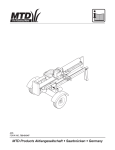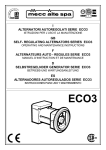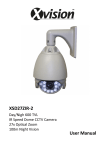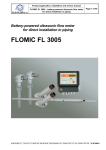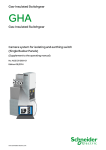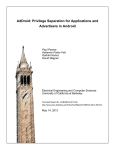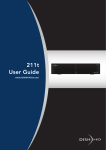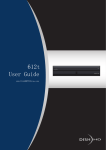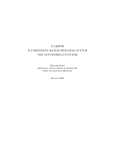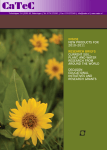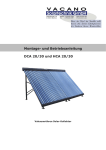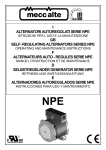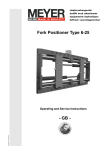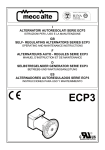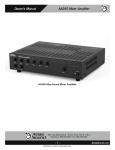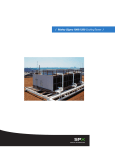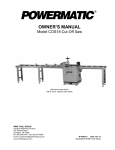Download Three-Phase Synchronous Motors
Transcript
Three-Phase Synchronous Motors VEM group VEM Sachsenwerk GmbH VEM motors GmbH VEM motors Thurm GmbH Keulahütte GmbH 800 to 35,000 kW VEM Products Low-voltage machines Three-phase asynchronous motors with squirrel-cage and slipring rotor up to 500 kW Rollertable motors up to 160 kW Explosion-protected motors up to 630 kW Crane motors and marine motors Special motors with brake, forced ventilator, encoder Compact drives up to 22 kw Energy-saving motors Built-in motors Tree-phase asynchronous generators High-voltage machines High-voltage asynchronous motors up to 28 MW High-voltage synchronous motors up to 35 MW High-voltage synchronous generators up to 45 MVA Traction machines Windpower generators up to 5.4 MW Foundry products Customer-made castings Fittings, valves, hydrants Your contact: www.vem-group.com we get things moving SWD/04-007 E/0405 GD Printed in the Federal Republic of Germany. Changes reserved. Sliding valves, flap valves Page Foreword 5 1. Summary of supply 6 1.1 Synchronous motors with constant speed and 6 brushless excitation 1.2 Synchronous motors with speed control 7 2. Type designation 8 3. Norms and regulations 4. Synchronous motors for constant-speed 9 10 applications 4.1 Voltage and frequency 4.2 Rated power output and heat generation 10 10 4.3 Direction of rotation 10 4.4 Overload capacity 10 4.5 Start-up 11 4.6 Modifications 11 5. Converter-fed, variable-speed 12 synchronous motors 6. Design description 13 6.1 Stator 13 6.2 Rotor 14 6.2.1 Rotor types 14 6.2.2 Description of the design and layout 14 6.3 Connecting boxes 15 6.4 Bearings 16 6.5 Cooling 18 6.6 Closed-loop control 18 6.6.1 Integration into E-systems 18 6.6.2. Excitation cabinet 19 6.6.3. Function of the excitation system 19 6.7. Excitation 20 6.7.1 Description of the design and layout of 21 the excitation machine Cover picture Tree-phase synchronous motors 6.7.2 Start-up on the converter 21 6.7.3 Asynchronous low-load start-up 22 6.7.4 Asynchronous high-load start-up 22 6.7.5 Static excitation 23 7. Explosion-proof motors 24 8. Universal VEMoDUR insulation system 26 9. Inspections 28 10. Documentation 29 11. Shipping, packaging, and installation 30 12. General instructions 31 13. Technical data 32 14. Industry solutions 36 Foreword VEM is one of the leading European suppliers of electrical machines for industrial applications. Our range of three-phase high-voltage synchronous machines is primarily used in applications in the chemical and petrochemical industry, in steel and rolling mill technology, in shipbuilding, in the cement industry and in the manufacturing industry. With this range we can offer our customers a choice of high-performance drives with a global pedigree. In their various design applications and different protection classes and cooling types, the drives are suitable for use in piston compressors, milling drives, pumps, fans, blowers and transformers. 4 VEM can offer the right solution for any application with customer-specific and application-orientated machines. The are characterised by reliability, ease of maintenance, modular design, high utilization and low noise emissions. A solid design concept ensures the high level of adaptability required to be able to incorporate individual customer requirements. Comprehensive know-how in the factory and constant further development in collaboration with institutes and universities guarantee high-quality customer-specific solution. The main features include: • Long service life of windings with high, reliable switching frequency thanks to the use of the universal VEMoDUR insulating system, wich is backed with decades’ of experience. • Inherent 20% thermal reserve built in tho the motors as standard. • Splinter-proof design of terminal boxes. • Good weight-to-performance ratio offers improved installation conditions. • Modular motor design ensures that spare capacity can be built into the system both easily and cost-effectively. • Minimal maintenance requirements, particularly on variants with brushless excitation. • Electromagnetic optimisation delivers high degree of utilization. • Excitation devices for motors without brushes ands for slipring motors supplied with automatic synchronisation and asynchronous running protection. All motors are designed in a customer-specific manner to fulfil the special application criteria. The catalogue contains general technical explanations. Individual requirements must be treated separately. The technical data for the basic series are also available on request from VEM. We request that interested parties contact our factory sales department or VEM sales offices and VEM representatives. Orders require our written confirmation. Note: We make every effort to constantly improve our products. For this reason, versions, technical data and illustrations may be changed. They are not binding until confirmed in writing by the supplying factory. 5 1. Summary of supply 1.2 Synchronous motors with speed control P/kW 1.1 Synchronous motors with constant speed and brushless excitation Power in kW 20,000 18,000 Voltage: Frequency: 16,000 14,000 Thermal class: 6 kV 50 Hz Power factor: cos ϕ = 0.9 F / utilization B 3 Centre height/mm 2 1,120 12,500 1,000 10,000 8,000 104 9 8 6,000 4,000 900 7 2,000 6 1,000 800 5 800 4 600 710 560 3 500 400 1,500 1,000 750 600 500 4 6 8 10 12 630 2 Speed (min-1) Number of Poles Power in kW 35,500 30,000 Voltage: 10 kV Frequency: 25,000 22,500 Thermal class: 50 Hz Power factor: cos ϕ = 0.9 F / utilization B 20,000 103 9 8 7 6 18,000 Greater numbers of poles available on request. 14,000 5 4 11,200 9,000 3 5,000 Correlation: Power, speed, centre height 1,120 800 710 102 2 3 4 5 6 7 8 9 103 6 2 n/min-1 560 1,500 1,000 750 600 500 4 6 8 10 12 Speed (min-1) Number of Poles • Thermal class F / utilization B • Rated voltage < 6 kV • Air-to-water heat exchanger with forced ventilator • xd“ = 11 – 16% • Excitation: brushless/with brush 7 2. Type designation 3. Standards and regulations The Sachsenwerk model designations consist of letters and numbers. Letters Numbers Numbers/letters Position 1-5 Position 6-9 Position 10-14 (variable, depending on the machine type) The motors comply with the applicable DIN standards and the DIN VDE regulations. For the basic designs, these include, in particular, DIN EN 60034 (VDE 0530) and IEC 60034 with its parts: Part 1 DMM V X Position 1 2 3 4 5 2 1 0 6 6 7 8 9 4 8 WD 10 11 12 13 Part 2 Part 4 14 Part 5 1 2 3 Type of current E = Single-phase AC D = Three-phase AC M = Multiple-phase AC Machine type A AC current K AC current B AC current S AC current G AC current R AC current M AC current T AC current C AC current U AC current Part 7 Part 8 asynchronous generator asynchronous squirrel cage rotor motor asynchronous slip ring rotor motor with BAV asynchronous slip ring rotor motor without BAV synchronous generator with slip rings synchronous generator without slip rings synchronous motor with slip rings synchronous motor without slip rings commutator motor single-housing converter Cooling type, protection class E Ventilated cooling / self-cooling without add-ons (IP00; IP10; IP20; IP21; IP22; IP23) A Ventilated cooling / self-cooling with add-ons (IP23; F Ventilated cooling / self-cooling pipe connection with internal fan (IP44; IP54; IP55) L Draft ventilation / forced-air cooling supplemental ventilation unit or pipe connection (IP00; IP10; IP20; IP21; IP22; IP23; IP24) B Draft ventilation / forced-air cooling pipe connection (IP44; IP54; IP55) R Circulation cooling / self-cooling air-to-air cooler (IP44; IP54; IP55) K Circulation cooling / self-cooling air-to-water cooler (IP44; IP54; IP55) S Circulation cooling / forced-air cooling with air-to-air cooler with additional ventilation unit (IP44; IP54; IP55) M Circulation cooling / forced-air cooling with air-to-water cooler with additional ventilation unit (IP44; IP54; IP55) N Circulation cooling / self cooling or forced-air cooling with gas as refrigerant (except air); all protection ratings O Surface cooling / self-cooling with cooling holes (IP44; IP54; IP55) C Surface cooling / self-cooling with cooling fins (IP44; IP54; IP55) P Surface cooling / self-cooling without fan (IP44; IP54; IP55) W Surface cooling / forced-air cooling with water cooling jacket (IP54) V Surface cooling / forced-air cooling with additional ventilation unit (IP54) 4 and 5 Design type (encoded) Bearings, deviating voltage and frequency, Explosion protection, construction, high-load start, etc. 6 and 7 Shaft centre height (encoded) 8 and 9 Stamping pack length (encoded) 10 and 11 Number of poles/speed 12 to 14 Additional letter for rework stage and special conditions Letter codes for special winding designs 8 Part 6 Part 9 Part 14 Part 15 Part 16 Part 18 Dimensioning and operational behaviour DIN EN 60034-1 (VDE 0530-1) - IEC 60034-1 Methods for determining the loss of efficiency ... DIN EN 60034-2 (VDE 0530-2) - IEC 60034-2 Methods for determining key synchronous machine variables from tests DIN EN 60034-4, VDE 0530-4, IEC 60034-4 Classification of protection classes DIN EN 60034-5 (VDE 0530-5) - IEC 60034-5 Classification of cooling methods DIN EN 60034-6 (VDE 0530-6) - IEC 60034-6 Classification of design types DIN EN 60034-7 (VDE 0530-7) - IEC 60034-7 Connection designations and direction of rotation DIN EN 60034-8 (VDE 0530-8) - IEC 60034-8 Noise limits DIN EN 60034-9 (VDE 0530-9) - IEC 60034-9 Mechanical vibrations ... DIN EN 60034-14 (VDE 0530-14) - IEC 60034-14 Surge voltage ratings ... DIN EN 60034-15 (VDE 0530-15) - IEC 60034-15 Excitation systems for synchronous machines DIN EN 60034-16… (VDE 0530-16) – IEC 60034-16 Functional evaluation of insulation systems ... DIN EN 60034-18-... (VDE 0530-18-...) - IEC 60034-18-... several parts as well as DIN ISO 10816-... Evaluation of the vibrations of machines - ISO 10816... through measurements of non-rotating parts... (several parts) DIN ISO 8821 Mechanical vibrations, agreement on the - ISO 8821 feather key type when balancing shafts and connecting parts DIN ISO 1940-... Requirements for the balancing quality of - ISO 1940... rigid rotors ... (several parts) DIN ISO 7919-… Measurement and evaluation of - ISO 7919 mechanical vibrations In the case of explosion-proof machines, the fundamental safety requirements are ensured by designs that meet the standards: DIN DIN DIN DIN DIN DIN DIN DIN EN EN EN EN EN EN EN EN 50014 (VDE 0170/0171 part 60079-0 – IEC 60079-0 50016 (VDE 0170/0171 part 60079-2 – IEC 60079-2 50019 (VDE 0170/0171 part 60079-7 – IEC 60079-7 50021 (VDE 0170/0171 part 60079-15 – IEC 60079-15 1), 3), 6), 16), On request, the products can be supplied in accordance with other standards, such as IEC standards currently being ratified, as well as in accordance with special industry regulations, such as ZLM (additional supply agreements for high-voltage electrical motors in power plants), regulations from all of the major ship classification associations or the Shell specification. 9 4. Synchronous motors for constant-sped applications 4.1 Voltage and frequency In the basic design, the motors are dimensioned for a rated voltage of 6 kV and a rated frequency of 50 Hz, with a power factor of cos ϕ = (0.9 ever-excited). Voltage and frequency fluctuations during operation are possible in agreement with the stipulations in DIN EN 60034-1 (VDE 0530 part 1), IEC 60034. Motors for voltage ranges ) 3.3 kV have higher, motors for voltage ranges > 6.6 kV lower rated outputs with the same construction models. 4.2 Rated power output and heat generation The rated outputs stated in the summary of supply hold for continuous operation (S1) at rated frequency, rated voltage, installation altitude ) 1,000 m above sea level and a maximum cooling air entry temperature of 40°C or cooling water entry temperature of 27°C. The maximum winding temperatures correspond to thermal class B in accordance with DIN IEC 60085 (VDE 0301 part 1), IEC 60095, measured using the resistance method. 10 Motors can be supplied with a maximum permissible temperature rise in accordance with thermal class F. 4.3 Direction of rotation As a general rule, the synchronouse motors must only be operated in the agreed direction of rotation. Special fans can be used in cases requiring bi-directional operation. Fans for bi-directional operation cause greater frictional losses and therefore achieve a lower efficiency. 4.4 Overload capacity The synchronous breakdown torque is 1.5 / 1.35 times the rated torque for salient-pole motors and smooth-core rotor motors respectively. Depending on the drive task in hand, these values can be modified. 4.5 Start-up The motors are designed for a direct start-up. In principle, reduced start-up current can be achieved by: • reducing the stator voltage with an autotransformer or reactance coil. • frequency start-up Pole design solid laminated with start-up cage Load moment fan piston compressor The parameters of the machine need to be quoted in all cases so that the start-up conditions can be assessed, including: • load moment curve (from idling to rated speed) • mass moment of inertia • maximum permitted mains voltage breakthrough during the start-up phase • number of start-ups in direct sequence 4.6. Modifications • Rated voltage up to 13.8 kV • 60 Hz or other rated frequency • Power factor control • Large-scale and special motors for rated torques of up to 2,000 kNm • Air-to-air hear exchanger • Start-up with additional resistor in the rotor circuit for difficult start-ups • Explosion-proof version MA /MN = f(n/nN) Schematic diagrams of the start-up torque depending on pole design. 11 5. Converter-fed, variable-speed synchronous motors 6. Design description Synchronous motors with variable speed control are used in a wide variety of industrial applications. Synchronous motors with a rated power output in excess of 1 MW have established themselves ahead of DC drives particularly in rolling mills, on ships and in the chemical industry. 6.1 Stator The stator housing is a welded construction comprising end walls and intermediate walls with support ribs, bars and sheet casing. It stands on base plates on the foundations. The stamping pack consists of insulated dynamo sheet round plates or overlapped layered dynamo sheet segments, and it is axially tensioned over end plates with press pins and weldedon bars. On machines with a diameter of up to 4,000 mm, the stamping pack is wound with whole pulled coils, fully impregnated according to the VPI process and shrink-fitted into the stator housing. On larger machines, the insulated dynamo sheet segments are overlapped and layered on guide bars in the housing, tensioned and then wound with vacuum-pressure impregnated transposed conductor rods or pulled coils which are premanufactured according to the resin-rich process. The three-phase stator winding lies in the open slots of the stamping pack. Depending on the rated power output, it is implemented as a double-layer whole pulled coil or double-layer transposed conductor winding. With the whole pulled coil, the conductive material is made of flat copper wire which is insulated with mica foil. For the conductors of the transposed conductor winding twisted in the slot part, lacquer-fibreglass-insulated flat copper wires are used and fastened as a wire bundle with mica-prepreg. The main insulation of the coils or rods consists of mica-fibreglass tape. To avoid corona discharges, a low impedance mica protective cover is installed in the slot part and a high impedance protective cover is installed in the slot exit. The fully insulated conductor packages are fixed in the slots using slot connectors. The winding heads are safely supported against the mechanical loads arising during switching operations due to binding, spacer pieces or retaining rings. The switch connections are hard-soldered at the whole pulled coil winding; in the case of transposed conductor windings, the rod connections are made through TIG-inert gas shielded arc welding. • dynamic and quasi-stationary overload torques on rolling mill motors • adaptation of the electromagnetic parameters to the special requirements of speed-controlled drives • additional insulation of the bearings on the D end and spindle grounding brush depending on the type of converter used. The advantages of synchronous machines include: • greater power and speeds can be achieved with the engine • robust design which is adapted to the drive tasks • low-maintenance operation • high degree of efficiency • speed setting can be used with a wide field suppression range • commutation reactive power (load-controlled inverter) can be taken over Depending on the system components and drive-specific requirements, the motors can be implemented in the form of smooth core rotor motors or salient-pole motors, or with/without brushes. The operation of the motors on frequency converters results among other things in a higher noise level than with sinusoidal mains power networks. In the case of converters, the increase in the acoustic pressure level depends on: Design concept In contrast to conventional synchronous machines, the design of converter-fed machines also takes the following aspects into account: • dimensioning of the stator winding insulation for operation on a direct converter or indirect converter and the relevant rated voltage • converter type Synchronous motor for frequency converter operation, rolling mill drive, type DMMYZ 8044-6Y Stator for rolling mill drive, type DMMYZ 2246-6Y 12 • pulse frequency • pulse pattern • output filter In the case of converter-fed machines, the converter type must be stated in the inquiry. 13 6.4 Bearings The type of bearings used depends on the requirements resulting from the mechanical loads and the machine which is to be driven. As a general rule, an attempt is made to ensure maximum operational safety and reliability and maximum service life. Rolling bearings The motors are equipped with DIN-standard rolling bearings. A deep groove ball bearing is used as a guide bearing on the D end. At absorbs the radial and (low) axial loads. A cylinder roller bearing is used as a floating bearing on the ND end. Under increased mechanical loads and higher speeds, the deep groove ball bearing on the D end is reinforced with a cylinder roller bearing. At lower speeds, a deep groove ball bearing is used at the ND end instead of the cylinder roller bearing as a floating bearing in an axial position. In applications where the synchronous motor is designed to absorb additional axial loads, a special bearing with pre-loaded angular contact ball bearings is used. The axial loads and radial loads should be quoted in the request / specification. All rolling bearings are lubricated with lithium-base-saponified grease of consistency class 3. The bearing modules are equipped with an automatic grease quantity control system. This ensures perfect lubrication levels after re-greasing. In accordance with the specifications in the motor documentation, the bearings must be regularly re-greased with the indicated type and quantity of grease in order to make sure that the bearings achieve their nominal service life. This is done using M10x1 flat grease nipples in accordance with DIN 3404. The bearings for smaller synchronous motors are equipped with a storage receptacle for the old grease. Provided the proper re-greasing schedule is followed, this receptacle is large enough for the calculated service life of the bearings. Bearings for larger motors have storage receptacles for old grease which can be emptied from outside. The bearings are sealed to the inside of the motor and to the outside with gap seals. They are maintenance-free and protect against penetration of dust and water. The bearing heads on the ND end are insulated against the motor housing to prevent bearing currents. The rolling bearings are monitored via Pt100 temperature measurements. Versions can be implemented with vibration monitoring. Sliding bearings Depending on the design of the machine, the sliding bearings can be designed as flange bearings or as pedestal bearings, or they can be centred on the end plate. The types of bearing used include bearings with a split housing, split bearing shells and split lubricating rings and sealing rings. This enables bearings to be serviced and sealing rings to be replaced without the need for disassembly of adjacent motor component groups or couplings. The protection class of the bearings in their basic design is IP 44. Higher protection classes (IP54 or IP55) can be achieved by using additional seals/gaskets. The bearing shell of the sliding bearing on the ND side is insulated to prevent bearing currents. The sliding bearings are usually designed as floating bearings, i.e. the motor rotor is guided via a coupling with limited axial clearance by the supporting bearing of the machine. It is also possible to use a locating bearing if no axial forces are directed from the machine or coupling onto the motor spindle. Special bearing shells are used for applications where axial forces need to be absorbed. The sliding bearings are preferably cooled via heat dissipation through the surface of the bearing housing. If the operating conditions do not allow this, then the bearings can also be cooled with rinsing oil or via an integrated water cooler. At low speeds or in applications with greater rotor masses, a hydrostatic rotor boost is used. Lubrication is provided by means of lubricating oils with a viscosity class which is governed by the operational data of the sliding bearing. Use of other oils must be agreed with VEM. Appropriate oil supply units are available from VEM for the use of rinsing oil to cool the bearings. The bearing shells on the ND end are insulated to prevent bearing currents. Monitoring is preferably implemented via Pt100 temperature measurements. A version with vibration dampers is available. For connection to a rinsing oil system, we can supply choke screws (which are used to control the flow rate of the oil) and a flow rate display unit or monitor. Rolling bearings 16 Sliding bearings 17 6.5 Cooling The machine is air-cooled inside. The air is either pumped axially or radially through the rotor and stator via fan wheels which are attached to the spindle (self-cooling) or via additional add-on fans with a motor (forced ventilator). In the process, the air absorbs waste heat from the stamping pack and the windings. The choice of cooling method depends on the overall plant project and is primarily governed by the required protection rating and the available media. Standard cooling methods include: Open cooling circuit (up to protection rating IP23) Ambient air is used as cooling air. Once it has cooled the machine it is discharged back into the atmosphere. Appropriate shutters are used to ensure that the required protection rating is attained. Closed cooling circuit with connected heat exchanger (protection rating IP44 and above) The cooling air inside the motor is pumped to a closed circuit (primary circuit), where it discharges its heat via a heat exchanger to a cooling medium (secondary circuit). Air-to-water or air-to-air heat exchangers are used. In the case of air-to-water heat exchangers, the pipe material used is governed by the quality of the cooling water. Doublepipe versions and versions with water leakage warning systems and flow monitors are also available. In the case of air-to-air heat exchangers, the outside air is Open cooling circuit 18 pumped through the heat exchanger by means of additional forced ventilators. 6.6 Closed-loop control 6.6.1 Integration into E-systems When the synchronous motor is operated directly off the mains supply, the excitation unit represents the control link between the E-system and the motor. This applies to both brushless and static excitation systems which have analogue or digital excitation control. Depending on the size of the motor and the configuration of the E-system, a greater or lesser number of control functions are performed or assessed by the excitation unit. Key features of the synchronous machine are achieved through open and closed-loop control of the excitation, as a result of which the scope of functions of the excitation unit may vary to a great extent depending on the specific requirements from the plant project. Excitation control functions are used among other things to influence the start-up behaviour, the stability during non-stationary processes and the re-synchronisation behaviour. The open-loop excitation control enables the following functions to be implemented within the program: • • • • • Anti-blocking protection Start-up monitoring (Deliberate) synchronisation Crank angle control Triggering of protection systems Closed cooling circuit (air-to-air) • • • • • • • • Asynchronous running protection with re-synchronisation Setpoint adjustment Controller status control (Auto/Manual…) Warning and error message displays On-site controls via operator panel Rotating diode monitoring Controller monitoring Rotor ground fault monitoring The exchange of signals for plant control purposes takes place digitally via the mutual provision of potential-free relay contacts or relay coils. The exchange of analogue signals takes place via potential-free coupling blocks with standardized current or voltage outputs. Other methods for exchanging signals, such as serial bus links, can be modified to suit specific requirements. 6.6.2 Excitation cabinet The excitation unit is usually laid out as a switching cabinet, on static installations also as a combination of several switching cabinets. On simple devices for low-power applications, other designs can also be supplied, including motor attachment, wall attachment or assembly plate attachment. The cabinet properties are adapted according to the specific requirements of any given application. The steel control cabinet contains the entire open and closedloop excitation control systems. An inspection window on the front door is available on request to provide a view of the important measuring instruments and displays. A bottom plate with PG screw fastenings can also be supplied for the cabinet, which is otherwise open at the bottom. Switching devices and, if applicable, the power section are located on the assembly plate in the rear of the cabinet. The open and closed-loop controllers are mounted on a pivoting frame. The pivoting frame is omitted on smaller units. In this case the open and closed-loop controllers are also housed on the assembly plate. 6.6.3 Function of the excitation system In principle, the closed-loop control of a synchronous motor via its excitation takes place under the aspects of drive stability and the specific requirements of the E-system or mains supply. Although these aspects are not mutually exclusive, the configuration of the overall system should be carefully balanced in both their favour. Closed-loop reactive power control is generally utilised, which operates with a subordinate (auxiliary) excitation current control on brushless systems, as this provides good settling times. As an alternative, cosj control can also be used as a derived form of reactive power control. Measured values which are only indirectly connected to the synchronous motor can also be used as the actual values for the controller, as a result of which the behaviour of the entire network island is influenced. Similar effects can also Closed cooling circuit (air-to-water) 19 be achieved variable setpoint specifications which are generated in a higher level control. A range of limiting controllers are used primarily to prevent a loss of stability of the motor. The limitation of the rotor displacement angle is based on a system of detecting the angle via inductive sensors in the motor. The excitation current control serves for servicing and manual operation purposes, as well as for simple operation from a higher level control. In the process, the internal setpoint is adjusted via HIGH/LOW signals. Depending on the project requirements, more or less complex analogue or digital devices are used. Basic functions: • Reactive power control • Digital setpoints • Manual operation • Excitation current control • Limitation of excitation current • Limitation of over and under-excitation 20 Possible upgrades: • Remote setpoint processing • External actual value processing • Limitation of rotor displacement angle • Stator current limitation • Reactive power limitation Depending on the required mode of operation for the motor, the excitation machine is laid out as either • a three-phase rotating armature excitation machine with DC supply on the stator side, or • a three-phase excitation machine with three-phase current supply on the stator side. Other functions required in addition to the above should be discussed with VEM. The rotor of the excitation machine supplies the excitation power to the excitation winding of the motor via rotating rectifier modules which are connected in a three-phase bridge connection. 6.7 Excitation The synchronous motors are supplied as brushless versions as standard. Alternatively, excitation via a slip ring arrangement is also available. The brushless version is maintenance-free and can also be used when the motor is operated in an atmosphere with an increased risk of explosion. 6.7.1 Description of the design and layout of the excitation machine The excitation machine is a three-phase external pole generator, the rotor of which is mounted together with the diode bridge and protective circuitry on a hub. This unit can be pulled off the spindle with minimal installation effort in terms of the excitation stator. The rotating brushless excitation unit (excitation machine, rectifier, start-up thyristor, protective circuitry and, if applicable, start-up resistor) can be arranged both inside and outside the machine. The stator of the excitation machine is supported by the end plate on the ND side, or it is supported by a supporting star on larger machines. The stator consists of a stamping pack made of insulated dynamo sheet round plates with stampedout poles. These poles carry a DC winding. If the synchronous machine is intended to be operated with a frequency-controlled start-up, then the excitation stator is laid out with a three-phase winding. Excitation cabinet Salient-pole rotor with excitation machine The rotor of the excitation machine is located on the rotor, where it is pulled on over a bush. The rotor has a stamping pack made of insulated dynamo sheet round plates with a three-stranded three-phase winding. A 6-pulse bridge circuit rotates together with the rotor to rectify the voltage induced in the excitation rotor. The output of the bridge is branched off to the excitation coil of the rotor. 6.7.2 Start-up on the converter The power supply to the stator winding of the synchronous motor is provided from the mains supply via a converter. The latter features a complex open and closed-loop controller which regulates the required output voltage of the converter according to the current operating point of the motor. In addition, the optimum excitation current for the excitation machine is also usually provided by the converter unit via a three-phase power controller. The excitation machine acts as a transformer during start-up. With increasing speed, this mode of operation is superseded by generator operation. In order to supply the voltage to the motor excitation winding, there is a three-phase diode bridge on the output of the rotor winding which is terminated on the DC side with a varistor or RC circuit to reduce transient voltage peaks. Rotor and diode bridge of the excitation machine 21 Depending on the application, the converter is only used during start-up. In the process, the power rectifier is bridged once mains synchronism is attained, as a result of which the motor is run directly off the mains. This means that the converter is only called upon during start-up, with the corresponding implications for dimensioning. Closed-loop excitation control is also provided by the converter complex during synchronous mains operation. 6.7.3 Asynchronous low-load start-up In the event of operation without supply from a converter and with a relatively low load moment, the brushless synchronous motor can also start up asynchronously, provided provisions are in place in the rotor circuit for the AC start-up current in the excitation coil. The positive half-wave of the AC start-up current flows through the rectifier diode bridge which is already in place. The negative half-wave flows anti-parallel through voltage-controlled thyristors to a diode branch of the rectifier bridge. The voltage-controlled triggering of the thyristors is achieved by virtue of the current-forcing character of the AC start-up current. The thyristors are reliably turned off during operation by being connected to the AC voltage of the excitation machine by means of voltage zero. 6.7.4 Asynchronous high-load start-up To start up the synchronous motor without a supply from a converter against a relatively high load moment, the excitation coil must be terminated with an optimised start-up ipedance. This has the effect that the asynchronous moment of the moment is increased, pull-up torques are prevented and tendencies to vibrate are significantly reduced. If the start-up impedance was to remain connected after synchronization has taken place, additional losses would be encountered. Suitable circuit connections are implemented to prevent permanent connection of the start-up impedance even with brushless excitation. At the same time, this method also achieves deliberate synchronisation. This synchronisation generates a very good synchronising moment and also enables the so-called crank angle control. Depending on polarity, the AC start-up current flows either through a diode or a voltage-controlled thyristor via the start-up impedance in the rotor circuit, whereby the series-thyristor remains untriggered. When the minimum slip is reached, the rotor displacement angle is sensed in order to connect the excitation voltage to the excitation coil by triggering the series thyristor. In the event of an overload, the sufficiently high slip component of the excitation current switches off the series thyristor, allowing the motor to be re-synchronised once the minimum slip is reached again. 6.7.5 Static excitation As an alternative to the brushless excitation method, a static excitation device can also be used. The advantages of this method are: direct access to the excitation circuit, omission of the auxiliary excitation time constant and comparatively highly dynamic response of the control system. The necessity of slip rings for transferral of the excitation current, the higher auxiliary power requirements and the additional expense of the excitation current actuator, which is balanced by the omission of the excitation machine, all need to be taken into account. There are no differences between the brushless and static excitation systems in terms of open and closed-loop control functions. The choice of which system is used depends primarily upon the varied requirements of the site where it is to be used, although the brushless excitation system is generally the standard choice. Slip ring arrangement The brush bridge consists of a brush carrier to which insulated brush pins with brush holders are attached. The brush carrier is supported by the end plate on the ND side, or it is supported by a supporting star on larger machines. A slip ring body is shrink-fitted to the spindle, and this in turn takes the slip rings which are made of stainless steel. There are branch-off conductors made of round copper on the slip rings which lead to the excitation coils of the rotor. 4 1 2 3 4 exciter mains converter motor Schematic diagram showing a rotor with connected converter 22 1 2 3 4 exciter-regulator exciter and rectifier bridge mains motor Rotor circuit diagram - asynchronous low-load start-up 1 2 3 4 5 exciter-regulator exciter and rectifier bridge mains motor firing Schematic circuit diagram showing the rotor during a heavy-load start-up 23 7. Explosion-proof motors Special regulations and directives apply to the setting-up of motors in explosion-hazardous areas in which dangerous concentrations of explosive atmospheres can build up. The areas are divided into zones (EN 60079-10 (VDE 0165 part 101), IEC 60079-10) and the production tools, i.e. the electric machines as well, are divided into device categories or ignition protection types. All European manufacturers must comply with the ATEX guidelines, which became legally binding as of 1 July 2003. 24 Depending on the conditions at the location of use, Sachsenwerk motors are delivered in accordance with DIN EN 50014 (VDE 0170/0171 part 1), DIN EN 60079-0 – IEC 60079-0 with the following types of ignition protection: • increased safety “e” (in accordance with DIN EN 50019 (VDE 0170/0171 part 6) and IEC 60079-7 – IEC 60079-7) – on request • pressurisation „p“ (in accordance with DIN EN 50016 (VDE 0170/0171 part 3), DIN EN 60079-2 – IEC 60079-2) • sparkless in normal operation „n“ (in accordance with DIN EN 50021 (VDE 0170/0171 part 16), DIN EN 60079-15 – IEC 60079-15) The fundamental safety requirements for explosion-proof motors in ignition protection type „e“ as per IEC 60079-7 are increased considerably compared to the previous design according to DIN EN 50019 so that, in the stage of contract preparation, a risk evaluation of possible ignition dangers should be conducted, and measures to minimise risk should be adopted if applicable. For high-voltage machines with rated voltage UN > 6 kV, a system test for the complete insulation system under an ignitable atmosphere remains necessary. The corresponding certificate of the PTB-Braunschweig as a recognized test authority is available for a Sachsenwerk insulation system VEMoDUR-VPI-155. Scavenging air control system (EEx p) Synchronous motor, 3.5 MW extruder drive (EEx p) 25 8. Universal VEMoDUR insulation system The operating reliability of electrical machines is determined to a large extent by the quality of their winding insulation. The insulation technology at Sachsenwerk has always been characterised by technical solutions which, in terms of their quality parameters, meet applicable international standards and thus ensure products which are highly reliable and offer their operators a long service life. The VPI technique (vacuum pressure impregnation) is used for high-voltage machines. The associated insulation system VEMoDUR-VPI-155 was developed at Sachsenwerk and is registered as a trademark . The designation “VEM” stands for “Vereinigter Elektromaschinenbau” and “DUR” for the duroplastic behaviour of the insulations with synthetic adhesives that are used. This system contains the following listed main components for the stator windings: Winding insulation Main insulation (groove and core chuck) Impregnating material ⇒ mica foil bands ⇒ mica-fibreglass bands (contains accelerator, low adhesive) ⇒ epoxy resin The components are optimally matched to each other. The insulation class F has been confirmed through many years of operating experience and functional evaluation as per DIN EN 60034-18-31 (VDE 0530 part 18-31) - IEC 60034-18-31. To guarantee the quality of the insulation system, all compo- nents are subjected to a receipt inspection in accordance with DIN EN ISO 9001 – ISO 9001. During the impregnation process, the insulation is subjected to a constant control system, whereby characteristics such as: • viscosity of the resin • impregnation and curing temperature • pressure maintaining times • under- and overpressure • pressure impregnation • are checked and documented. The insulation is cured in rotation. Vacuum-pressure impregnation guarantees a high mechanical strength (core chuck rigidity) and outstanding electrical strength. This holds especially for the distance sparkover voltages. Rated surge voltages in accordance with DIN EN 60034-15 (VDE 0530 part 15) – IEC 60034-15 are guaranteed for all machines with a great degree of reliability (see table extract). Insulation level of rotating electrical machines with stator pulled coil windings in accordance with DIN EN 60034-15 (VDE 0530 part 15) – IEC 60024-15 (extract) The insulation system is highly resistant to climate influences, Rated voltage UN in kV The insulation systems is highly resisitant to climate influences, i.e. the winding is not sensitive to humid or aggressive atmospheres. The VPI insulation system represents the standard design. The technically equivalent resin-rich insulating system is used on very large machines. With this system, resin-rich mica fibreglass insulating bands are bound onto the main insulation and the winding head insulation and then hardened in the slot part under pressure and heat. Within the framework of internal quality inspection in accordance with DIN VDE, electrical interim and final checks of the insulation strength are performed together with (on customer request) surge voltage and partial discharge level tests. This ensures a quality that meets market demands and competitive requirements. The VEMoDUR insulation system is also suitable for machines with "increased safety" ignition protection type EExe in accordance with DIN EN 50019 (VDE 0170/0171 part 6) as well as Exe as per IEC 60079-7 – IEC 60079-7. Rated surge Mains frequency voltage testing voltage (peak value) in kV (effective value) in kV Shaft 1.2/50 (2UN + 1 kV) (4UN + 5 kV) 6 6.6 29 31 13 14.2 10 11 45 49 21 23 13.8 15 60 65 28.6 31 VEM can also supply special designs with increased rated surge voltages on customer request. Example: UN = 11 kV Main insulation: 80 kV Winding insulation: 60 kV 26 27 9. Inspections An effective quality assurance and management system guarantees the optimal value and quality of the motors. Every motor is subject to an internal individual inspection. The results of the inspections are documented in an inspection log. This is part of the delivery documentation. Individual inspections • Visual inspection (identification, completeness, condition of construction, quality of assembly, brush type and dimensions etc.) • Air gap measurements (if permitted by the construction) • Insulation resistance of the windings, temperature probes, anti-condensation heaters, bearings (inspection performed during assembly) • Ohmic resistances of the windings, temperature probes, anti-condensation heaters • Measurement of the magnet wheel impedance • Setting of the magnetic centre for sliding bearings • Idling characteristic curve for determining magnetic and frictional losses, calculation check of efficiency, if required • Check of direction of rotation • Inspection of the voltage geometry • Winding checks • Vibration severity measurement • Short-circuit characteristic curve and loss measurement (generator method) • Determination of the SPM level (if corresponding feature is available) • Current overload test • Winding check (high voltage test) • Functional capability of the accessories Type inspections If the customer wishes, additional inspections can be performed within the scope of the type inspection. The addition- 28 10. Documentation al costs will be charged to the customer. In this case, the following inspections are conducted in addition to the individual inspection: • Overspeed test • Recording of the idling characteristic curve and loss measurement • Noise measurement at idle • Wave voltage measurement on machines with insulated bearings (if permitted by the construction) • Degree of distortion of the voltage curve • Measurement of the THF factor • Reactances and time constants – determination of the residual voltage • Short-circuit characteristic curve and loss measurement (motor method) • Surge short-circuit check • Load characteristic • Control characteristic • Determination of the nominal excitation current • Determination of the degree of efficiency • Air quantity measurements, pressure losses • Thermal test with rated data or substitute tests • Anti-condensation heating • Thermal time constants, load limit determination • Cooling time constants • Runout measurement, determination of the mass moment of inertia • Runup measurement, determination of the start-up characteristics • Determination of the key variables of the synchronous machine • Measurement of the SPM level • Operating characteristic curves η = f(Pel), cos ϕ = f(Pel), Pmech = f(Pel), s= f(Pel), l=f(Pel) Unless agreed otherwise, the „Operation and Service Manual“ documentation contains the following documents: • Safety instructions • EC manufacturer’s declaration • Description / technical data • Dimensional drawing of motor • Dimensional drawing of cable connections • Connection plans for temperature monitoring, anti-condensation heaters • Installation / assembly • Commissioning • Operation • Maintenance • Servicing • Replacement parts list • Test certificate / log book • Supplemental operation manuals (options, third-party suppliers) Any additional documentation beyond this scope must be agreed by contract. The documentation is provided in two copies when the product is delivered. It is available in all EU languages. VEM charges for costs of additional copies, additional documentation, and translation into other languages. 29 11. Shipping, packaging, installation 12. General instructions The type of packaging is determined at the time of contract according to the transportation and storage conditions specified in the order and takes into account the design and construction of the machines. VEM can offer all types of special packaging and provide shipping and installation of motors to any destination worldwide. If not expressly requested and offered otherwise, the machine is designed as follows: The machines are shipped either fully assembled or disassembled depending on the size and contractual agreements. VEM recommends the installation and commissioning service of our specialist personnel. 30 If the customer prefers to perform the installation and commissioning themselves or have this work done by a third party, then the performance of this work must be verified in section 9 (test certificates, logbook) of the VEM Operation and Service Manual, or by other means. Failure to comply with this requirement will absolve VEM from any liability or warranty obligations. The VEM Operation and Service Manual is delivered with the machine. If contractually agreed, the documentation can also be sent separately to the buyer or operator. • It is built with the insulation system VEMoDUR. • It is painted in accordance with Sachsenwerk Standard SW-N 170-004, which is based on DIN EN ISO 12944 ... – ISO 12944... and applicable standards. • The machine’s direction of rotation is right, when looking at the drive (D) end. The connecting box is positioned on the right. • The cooler is located on the machine and the water connection is on the left when looking at the drive (D) end. • Water cooler up to the connecting flange without monitoring on the water side. • Without cable stuffing socket. • PT 100 for winding and storage in 2-wire switch without trigger device, from terminal box connection in 2-, 3- and 4-wire design. • Mechanical vibrations correspond to the limits specified in EN 60034-14 and are proved in the test lab. • Vibration monitoring is performed without an evaluation device. 31 13. Technical data Power range Brushless high-voltage synchronous motors 6 kV 50Hz · cos ϕ = 0,9ü · Number of poles 4-12 · Thermal class F (utilization B) Typ Centre height Power range Brushless high-voltage synchronous motors 10 kV 50Hz · cos ϕ = 0,9ü · Number of poles 4-12 · Thermal class F (utilization B) 1500 min-1 Power output 1000 min-1 750 min-1 600 min-1 500 min-1 Typ 450 800 560 400 - - 450 1000 710 500 - - 5018 500 1250 900 630 500 400 5023 500 1600 1120 800 630 500 5621 560 2000 1400 1000 800 5627 560 2500 1800 1250 1000 6321 630 2800 2000 1400 6324 630 3150 2250 1600 6327 630 3550 2500 6329 630 4000 7125 710 7127 710 7130 Centre height Power output (mm) 1500 min-1 1000 min-1 750 min-1 600 min-1 500 min-1 - - - - - - - - - - - - - - 5018 500 1120 800 560 - - 5023 500 1400 1000 700 - - 630 5621 560 1800 1250 900 710 560 800 5627 560 2250 1600 1120 900 710 1120 900 6321 630 2500 1800 1250 1000 800 1250 1000 6324 630 2800 2000 1400 1120 900 1800 1400 1120 6327 630 3150 2250 1600 1250 1000 2800 2000 1600 1250 6329 630 3550 2500 1800 1400 1120 4500 3150 2250 1800 1400 7125 710 4000 2800 2000 1600 1250 5000 3550 2500 2000 1600 7127 710 4500 3150 2250 1800 1400 710 5600 4000 2800 2250 1800 7130 710 5000 3550 2500 2000 1600 7133 710 6300 4500 3150 2500 2000 7133 710 5600 4000 2800 2250 1800 8030 800 7100 5000 3550 2800 2250 8030 800 6300 4500 3150 2500 2000 8033 800 8000 5600 4000 3150 2500 8033 800 7100 5000 3550 2800 2250 8036 800 9000 6300 4500 3550 2800 8036 800 8000 5600 4000 3150 2500 8040 800 10000 7100 5000 4000 3150 8040 800 9000 6300 4500 3550 2800 9033 900 11200 8000 5600 4500 3550 9033 900 10000 7100 5000 4000 3150 9036 900 12500 9000 6300 5000 4000 9036 900 11200 8000 5600 4500 3550 9040 900 14000 10000 7100 5600 4500 9040 900 12500 9000 6300 5000 4000 9045 900 16000 11200 8000 6300 5000 9045 900 14000 10000 7100 5600 4500 1038 1000 18000 12500 9000 7100 5600 1038 1000 16000 11200 8000 6300 5000 1042 1000 20000 14000 10000 8000 6300 1042 1000 18000 12500 9000 7100 5600 1047 1000 - 16000 11200 9000 7100 1047 1000 20000 14000 10000 8000 6300 1053 1000 - 18000 12500 10000 8000 1053 1000 22500 16000 11200 9000 7100 1148 1120 - 20000 14000 11200 9000 1148 1120 25000 18000 12500 10000 8000 1153 1120 - - 16000 12500 10000 1153 1120 28000 20000 14000 11200 9000 1158 1120 - - - - - 1158 1120 31500 22500 - - - 1164 1120 - - - - - 1164 1120 35500 - - - - DT… (mm) 4516 4519 32 DT… 33 14. Industry solutions Excerpt Ordering party Object / Driven equipment Machine type Qty. Power output kW Rated voltage kV 2004 DMS ZI LILLE SECLIN Quingdao / China Rolling mill drive DMMYZ 8044-6Y 7 4,000 3.0 2003 Alstom Rasselstein /Deutschland Rolling mill drive DMMYZ 9040-4Y 1 4,000 2.0 2003 Alstom TKS Bruckhausen / Deutschland Rolling mill drive DMMYZ 2246-6Y 1 5,000 2.0 2003 Linde AG Kollsnes / Norwegen Turbocharger compressor drive DTKFU 1044-4WS EExp IIA T3 1 18,500 11.0 2003 Lungi LDPE Marun / Iran Piston compressor drive DTKVY 4931-30WS EExp II T3 1 22,400 11.0 2002 Siemens AG CISA RCM / Brasilien Coiler drive DMMYZ 8040-6 2 2,719 3.3 2002 Siemens AG CISA RCM / Brasilien Stand drive DMMYZ 1038-6 1 6,000 6.6 2001 Alstom Corus Staal B.V. / Niederlande Shearing drive DMMYZ 8027-8 2 3,000 1.35 2001 Alstom Lesum II / Deutschland Piston compressor drive DTMYZ 1025-10 EExp II T3 1 3,250 1.65 2000 Linde AG Luftverdichter Linz / Österreich Air compressor drive DTKYY 1131-6W 1 12,500 6.0 2000 STN Atlas Marine Electronics SKY II / Norwegen Propeller motor DTMYZ 3070-16 2 15,000 2.9 2000 Siemens AG Pingxiang / China Block drive DMMYZ 9036-6 1 6,300 1.75 1999 Salzgitter Anlagenbau LDPE-Projekt BASELL / Frankreich Piston compressor drive DTKVY 4937-30W EExp II T3 1 23,500 11.0 1999 Alstom / Mannesmann Demag Nosta / Russland Dual drive DMMYZ 3067-16 2 5,000 1.575 1997 Salzgitter Anlagenbau Novy Urengoy / GUS Piston compressor drive DTKVY 3253-30W EExp II T3 3 11,700 10.0 Year of delivery 34 35


















